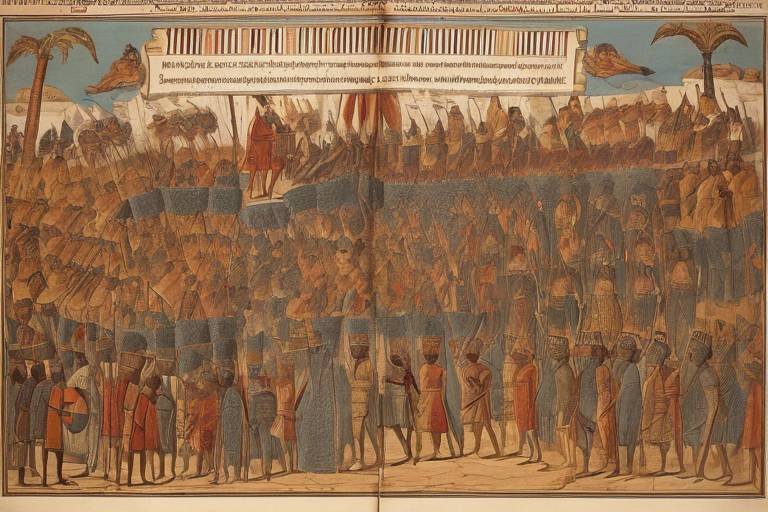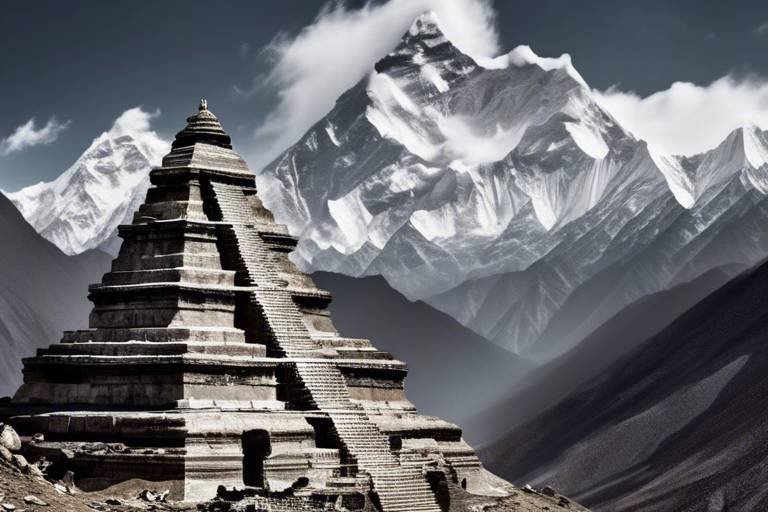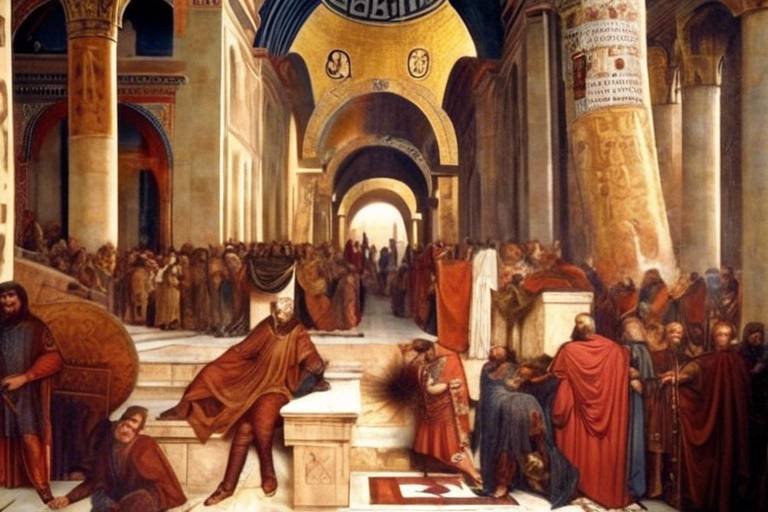The Influence of the Maya on Mesoamerican Cultures
The Maya civilization has left an indelible mark on Mesoamerican cultures through their remarkable advancements in various fields. From art and architecture to mathematics, astronomy, and religious practices, the Maya's influence resonates across time and space, shaping the rich tapestry of Mesoamerican heritage.
One of the most striking aspects of Maya culture is their artistic achievements. The Maya developed unique styles and techniques, evident in their intricate stone carvings, vibrant murals depicting scenes from daily life and mythology, and meticulously crafted pottery adorned with symbolic motifs.
When it comes to architectural marvels, the Maya stand out for their impressive structures. They built towering pyramids that served as ceremonial centers, elaborate palaces for the ruling elite, and well-planned urban centers with advanced drainage and irrigation systems.
In the realm of mathematics, the Maya were pioneers. They devised a sophisticated mathematical system that included the revolutionary concept of zero, positional notation for large numbers, and a complex calendar system that accurately tracked time and celestial events.
The Maya's astronomical knowledge was equally impressive. Through precise observations of the movements of celestial bodies, they developed a deep understanding of the cosmos. Their structures, such as temples and observatories, were aligned with astronomical phenomena, highlighting their astronomical prowess.
Religion played a central role in Maya society, shaping their beliefs and rituals. The Maya worshipped a pantheon of deities, performed elaborate ceremonies like bloodletting to communicate with the divine, and followed a sacred calendar that governed religious practices and agricultural activities.
The Maya language has also left a lasting legacy. Their hieroglyphic writing system, though initially misunderstood, has been deciphered, revealing insights into Maya history, culture, and beliefs. Today, elements of the Maya language persist in modern Mesoamerican cultures, underscoring the enduring influence of the ancient civilization.
Even in modern times, the Maya's legacy continues to thrive. Their traditions, art forms, and knowledge persist in contemporary Mesoamerican societies, influencing everything from cuisine and music to architecture and spirituality. The Maya's cultural contributions resonate globally, enriching the world's cultural diversity.
Recent archaeological discoveries have shed new light on the Maya civilization, uncovering hidden treasures and expanding our understanding of their connections to neighboring Mesoamerican cultures. These findings continue to deepen our appreciation for the Maya's ingenuity and resilience.

Maya Artistic Achievements
Exploring the profound impact of Maya civilization on various Mesoamerican cultures, including their advancements in art, architecture, mathematics, astronomy, and religious practices.
When delving into the artistic achievements of the Maya, one cannot help but marvel at the unique styles and techniques they developed. The Maya excelled in various forms of art, from intricate stone carvings that depicted their rich mythology to colorful murals that adorned their sacred spaces. Their detailed pottery, adorned with elaborate designs and vibrant colors, showcased their exceptional craftsmanship and artistic vision.

Maya Architectural Marvels
When it comes to Maya architectural marvels, one cannot help but be awestruck by the grandeur and sophistication of their structures. The Maya civilization showcased exceptional architectural skills, creating monumental buildings that still captivate modern-day observers. From towering pyramids to intricate palaces, the Maya left an indelible mark on Mesoamerican architecture.
One of the most iconic architectural features of the Maya civilization is their impressive pyramids. These towering structures, often built with precise mathematical and astronomical alignment, served as ceremonial centers and symbols of power. The famous Pyramid of Kukulkan at Chichen Itza is a prime example of Maya architectural ingenuity, with its intricate design and alignment with the movements of the sun.
Moreover, Maya palaces were not just places of residence for the elite but also centers of governance and cultural activities. These elaborate structures featured intricate carvings, expansive courtyards, and complex layouts that reflected the hierarchical structure of Maya society. The Palace of the Governor at Uxmal is a testament to the Maya's architectural prowess, with its intricate stone mosaics and well-planned layout.
Urban planning was another area where the Maya excelled, creating well-organized cities with advanced infrastructure. The city of Tikal, for instance, boasted a sophisticated network of roads, reservoirs, and agricultural terraces, showcasing the Maya's mastery of city planning and engineering.
Overall, Maya architectural marvels stand as a testament to the civilization's ingenuity and cultural sophistication. The intricate details, advanced construction techniques, and symbolic significance of Maya structures continue to fascinate archaeologists and historians, shedding light on the rich architectural legacy of the ancient Maya civilization.

Maya Contributions to Mathematics
The Maya civilization made significant contributions to the field of mathematics, pioneering concepts that were far ahead of their time. One of the most remarkable achievements of the Maya in mathematics was the development of a sophisticated numerical system that included the revolutionary concept of zero. Unlike many other ancient cultures, the Maya understood the importance of zero as a placeholder, allowing for complex calculations and the creation of a positional notation system.
In addition to zero, the Maya also utilized a base-20 numbering system, which was a departure from the more common base-10 systems used by other civilizations. This system, combined with their advanced understanding of arithmetic, allowed the Maya to perform intricate calculations and create precise astronomical predictions.
Furthermore, the Maya calendar system, known as the Mesoamerican Long Count calendar, showcases their mathematical prowess. This intricate calendar was based on a complex combination of cycles and intervals, allowing the Maya to accurately track time over long periods. The Long Count calendar played a crucial role in various aspects of Maya society, from religious ceremonies to agricultural practices.
Moreover, the Maya were adept astronomers, and their mathematical knowledge was closely tied to their observations of celestial bodies. By studying the movements of the sun, moon, planets, and stars, the Maya were able to develop a highly accurate calendar that aligned with astronomical events. This astronomical precision not only influenced their religious beliefs but also guided their agricultural practices and societal organization.
The Maya's mathematical achievements were not only groundbreaking for their time but also had a lasting impact on future civilizations. Their concepts of zero, positional notation, and advanced calendar systems laid the foundation for modern mathematics and influenced the development of mathematical thought worldwide.

Maya Astronomical Knowledge
The Maya civilization's astronomical knowledge was truly remarkable, showcasing their deep understanding of the cosmos and celestial bodies. They meticulously observed the movements of the sun, moon, planets, and stars, developing a complex system that intertwined astronomy with their religious beliefs and daily life. The Maya's keen observations allowed them to create precise calendars that accurately predicted celestial events like solstices, equinoxes, and eclipses. Their architectural structures, such as pyramids and temples, were often aligned with astronomical phenomena, serving as both ceremonial centers and astronomical observatories.
One of the most intriguing aspects of Maya astronomy is their use of Venus as a significant celestial body in their observations. Venus, known as the Morning Star and Evening Star, played a crucial role in Maya cosmology, with its movements influencing their religious ceremonies and agricultural practices. The Maya developed intricate Venus calendars that tracked its cycles with incredible precision, highlighting their advanced understanding of planetary motion and celestial mechanics.
Moreover, the Maya's astronomical knowledge extended beyond mere observation, as they also incorporated cosmological concepts into their mythological narratives. The Popol Vuh, the sacred book of the Maya, contains rich cosmogonic myths that intertwine celestial events with the creation of the world and the origins of humanity. This blending of astronomy, mythology, and spirituality underscores the holistic approach the Maya took towards understanding the universe.

Maya Religious Practices
The Maya civilization was deeply rooted in complex religious beliefs and practices that played a central role in their society. Their religious practices were intricate and encompassed various rituals, ceremonies, and mythological beliefs that shaped their worldview. The Maya worshipped a pantheon of deities, each associated with different aspects of life, nature, and the cosmos. These deities were believed to influence every aspect of Maya existence, from agriculture to warfare.
One of the most fascinating aspects of Maya religious practices was their ritual of bloodletting. Bloodletting was a sacred and symbolic act performed by Maya rulers and elites to communicate with the gods and ancestors. It involved piercing or cutting parts of the body, usually the tongue or genitals, to offer blood as a sacrifice. The bloodletting rituals were believed to ensure the renewal of life, maintain cosmic balance, and communicate with the spiritual realm.
The Maya also had a complex calendar system that played a crucial role in their religious ceremonies. They believed that time was cyclical and that events in the past, present, and future were interconnected. The sacred calendar, known as the Tzolk'in, consisted of 260 days and was used to determine auspicious dates for rituals, ceremonies, and divination practices. The Long Count calendar, with its intricate system of counting days, years, and cycles, was used for tracking historical events and predicting the future.
Additionally, the Maya practiced elaborate burial rituals and ceremonies to honor the deceased and ensure their journey to the afterlife. Tombs of rulers and nobles were adorned with valuable offerings, intricate pottery, and symbolic artifacts to accompany them in the underworld. These burial practices reflected the Maya's belief in the continuity of life beyond death and the importance of maintaining relationships with ancestors and supernatural beings.
Overall, Maya religious practices were deeply intertwined with every aspect of their culture, from art and architecture to politics and daily life. The intricate belief systems, rituals, and ceremonies of the Maya continue to fascinate archaeologists, historians, and enthusiasts, offering a glimpse into the spiritual world of one of the most advanced civilizations of ancient Mesoamerica.

Maya Influence on Language
The Maya civilization had a profound influence on language within Mesoamerican cultures, leaving a lasting impact that is still felt today. One of the most significant contributions of the Maya to language was the development and use of hieroglyphic writing. This intricate system of writing, composed of symbols and glyphs, was used to record historical events, religious rituals, and astronomical observations. The Maya hieroglyphic writing system has provided valuable insights into their culture, beliefs, and daily life.
In addition to their hieroglyphic writing, the Maya language itself has had a lasting influence on modern Mesoamerican cultures. Many words and linguistic elements from the ancient Maya language have been preserved and incorporated into contemporary languages spoken in the region. This linguistic legacy serves as a reminder of the rich cultural heritage of the Maya civilization and their enduring impact on language.
Furthermore, the study of Maya language and hieroglyphic writing has allowed researchers to decipher ancient texts and gain a deeper understanding of Maya society. Through linguistic analysis, scholars have been able to reconstruct historical narratives, decode ceremonial inscriptions, and unravel the complexities of Maya religious beliefs. The preservation of the Maya language has been crucial in unlocking the mysteries of this ancient civilization.

Maya Legacy in Modern Times
Even in modern times, the legacy of the Maya civilization continues to exert a significant influence on various aspects of Mesoamerican cultures. The rich tapestry of Maya traditions, art, and knowledge has woven its way into contemporary societies, shaping not only local customs but also leaving a mark on global culture. The enduring impact of the Maya can be seen in the vibrant colors and intricate patterns of traditional textiles, the flavors of ancient recipes still enjoyed today, and the echoes of ancient rituals in modern ceremonies.
One of the most striking examples of the Maya legacy in modern times is the preservation of their language. Despite centuries of cultural change and upheaval, Maya languages are still spoken by millions of people in the region. The intricate hieroglyphic writing system used by the Maya has also been studied and deciphered, shedding light on their history and beliefs.
Furthermore, Maya art continues to inspire contemporary artists, with its bold colors, intricate designs, and symbolic motifs finding their way into modern creations. The architectural marvels of the Maya, such as the majestic pyramids and grand palaces, stand as a testament to their engineering prowess and continue to draw visitors from around the world.
In addition to the tangible aspects of Maya culture, their spiritual beliefs and practices have also left a lasting impact. The reverence for nature, the cycles of life and death, and the interconnectedness of all living beings are themes that resonate with many modern individuals seeking a deeper connection to the world around them.
As archaeologists continue to uncover new insights into the Maya civilization, our understanding of their legacy in modern times grows ever more profound. The intricate web of connections between the past and the present reveals a cultural richness that transcends time, inviting us to explore and appreciate the enduring influence of the Maya on Mesoamerican cultures.

Maya Archaeological Discoveries
Maya archaeological discoveries have continued to captivate researchers and enthusiasts alike, shedding new light on the rich history and culture of this ancient civilization. Recent excavations have unearthed a treasure trove of artifacts, revealing intricate details about Maya daily life, religious practices, and societal structure.
One of the most significant archaeological findings is the discovery of elaborate tombs belonging to Maya rulers and elite members of society. These tombs are adorned with precious artifacts, intricate carvings, and hieroglyphic inscriptions that provide valuable insights into the Maya's beliefs about the afterlife and the importance of lineage.
Furthermore, excavations at Maya city-states have uncovered vast ceremonial complexes, ball courts, and residential areas, showcasing the sophisticated urban planning and architectural prowess of the Maya civilization. The layout of these cities reflects a deep connection to astronomy and religious practices, with structures aligned to celestial events and deities.
Recent archaeological research has also focused on deciphering Maya hieroglyphic writing, a complex system of symbols used to record historical events, religious ceremonies, and dynastic successions. By decoding these inscriptions, scholars have been able to piece together a more comprehensive understanding of Maya history and societal structure.
Moreover, the excavation of Maya agricultural sites has provided valuable information about the cultivation techniques and staple crops of the ancient civilization. The Maya's ability to sustain large populations in a challenging environment speaks to their ingenuity and resourcefulness in agricultural practices.
In conclusion, Maya archaeological discoveries continue to unveil the mysteries of this enigmatic civilization, offering a glimpse into their advanced knowledge, intricate belief systems, and enduring legacy in Mesoamerican cultures.
Frequently Asked Questions
- What were the major artistic achievements of the Maya civilization?
The Maya civilization was known for its unique artistic styles, including intricate stone carvings, colorful murals, and detailed pottery. These artistic achievements reflected the Maya's advanced skills and cultural sophistication.
- How did the Maya contribute to mathematics?
The Maya made significant contributions to mathematics, developing a sophisticated mathematical system that included the concept of zero, positional notation, and a complex calendar system. Their mathematical achievements were ahead of their time and influenced future civilizations.
- What architectural marvels did the Maya build?
The Maya constructed impressive architectural structures, such as towering pyramids, elaborate palaces, and advanced urban planning. These architectural marvels showcased the Maya's engineering prowess and cultural significance.
- What is the significance of Maya astronomical knowledge?
The Maya had advanced understanding of astronomy, demonstrated by their precise observations of celestial bodies and alignment of structures with astronomical events. Their astronomical knowledge played a crucial role in their religious practices and societal organization.
- How did Maya religious practices influence their society?
Maya religious practices were intricate and deeply ingrained in their society, involving rituals like bloodletting ceremonies, reverence for deities, and sacred calendar rituals. These practices shaped Maya culture, beliefs, and social structure.



















